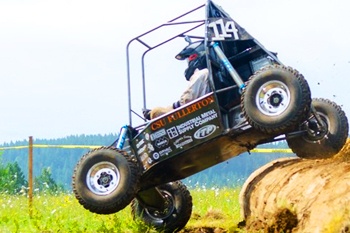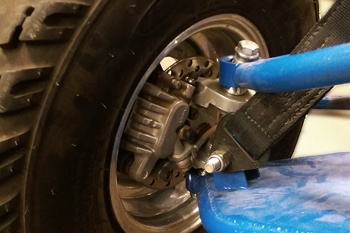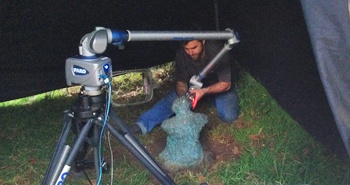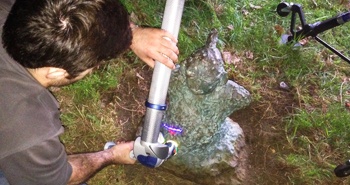
California State University, Fullerton’s Titan Baja SAE (Society of Automotive Engineers) team sought Q-PLUS Labs’ measurement expertise to assist in jump starting the team’s 2015 season since their 2008 competition hiatus. Originating in 1976 at the University of South Carolina, the objective of this comprehensive engineering competition is for students to function as a team to not only design, build, test, promote, and race a vehicle, but also raise financial support while balancing the demands of their course work. To produce a formidable competitor at the 2015 Baja SAE race, the final single-seat, all-terrain sporting vehicle comprised of parts machined by CSUF’s Baja team from scrap, over the course of 9 months.
Introduction
 Before building their vehicle, CSUF's Baja team designed a virtual rendering of it in Solidworks, a 3D CAD design software. Because each piece of the car was hand machined, the team needed accurate measurements of the car’s calipers before proceeding with the build. Calipers are essential to the vehicle’s ability to stop and are one of the critical components of a car’s breaks. The challenging track consisted of rough terrain, making the measurements extremely vital to vehicle’s ability to successfully navigate the race.
Before building their vehicle, CSUF's Baja team designed a virtual rendering of it in Solidworks, a 3D CAD design software. Because each piece of the car was hand machined, the team needed accurate measurements of the car’s calipers before proceeding with the build. Calipers are essential to the vehicle’s ability to stop and are one of the critical components of a car’s breaks. The challenging track consisted of rough terrain, making the measurements extremely vital to vehicle’s ability to successfully navigate the race.
Our Process
Due to its complex geometry, the calipers posed a challenge for the team to model quickly. Using Q-PLUS Labs’ 3D scanning services, the team was able to “test fit” the calipers on the solid model before it was even made. Using the FARO Edge  ScanArm HD, a 3D laser scanner which rapidly collects high accuracy point cloud data, Q-PLUS Labs was able to provide the team the measurement data they needed despite the reflective surface of the calipers. The scanning information that Q-PLUS Labs provided the team reduced the amount of time it would have taken them to machine the vehicle’s parts to fit the calipers.
ScanArm HD, a 3D laser scanner which rapidly collects high accuracy point cloud data, Q-PLUS Labs was able to provide the team the measurement data they needed despite the reflective surface of the calipers. The scanning information that Q-PLUS Labs provided the team reduced the amount of time it would have taken them to machine the vehicle’s parts to fit the calipers.
Defying the odds of the Baja SAE race where cars were breaking down along the grueling track, CSUF’s Titan Baja team finished the race with 11 laps. Forging ahead and looking to be in the top 20 finishing teams, they are not wasting any time preparing for 2016’s race in Gorman, California on May 19th-22nd.





 Nam June Paik designed this installation which is composed of televisions paired with Buddhas watching them to depict extended contemplation. As an integral aspect of UCSD's landscape, the university sought to preserve the statues via 3D scan data in case the statues would need to be recreated in detail. For this particular application, Q-PLUS Labs' engineers used white light and laser scanning technology, specifically the
Nam June Paik designed this installation which is composed of televisions paired with Buddhas watching them to depict extended contemplation. As an integral aspect of UCSD's landscape, the university sought to preserve the statues via 3D scan data in case the statues would need to be recreated in detail. For this particular application, Q-PLUS Labs' engineers used white light and laser scanning technology, specifically the 

